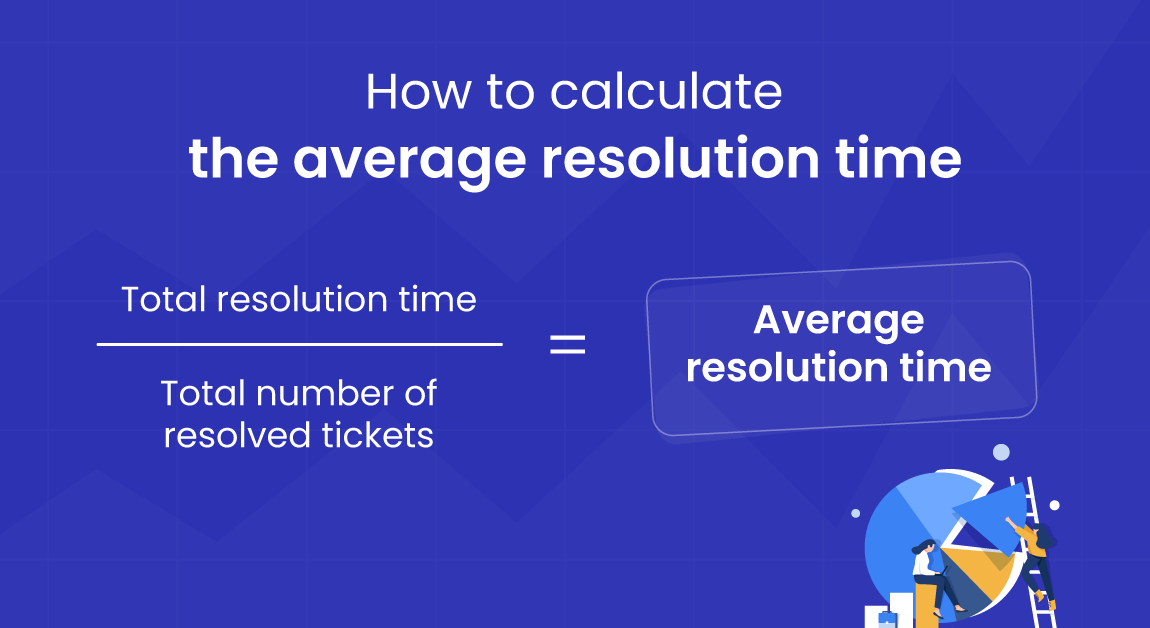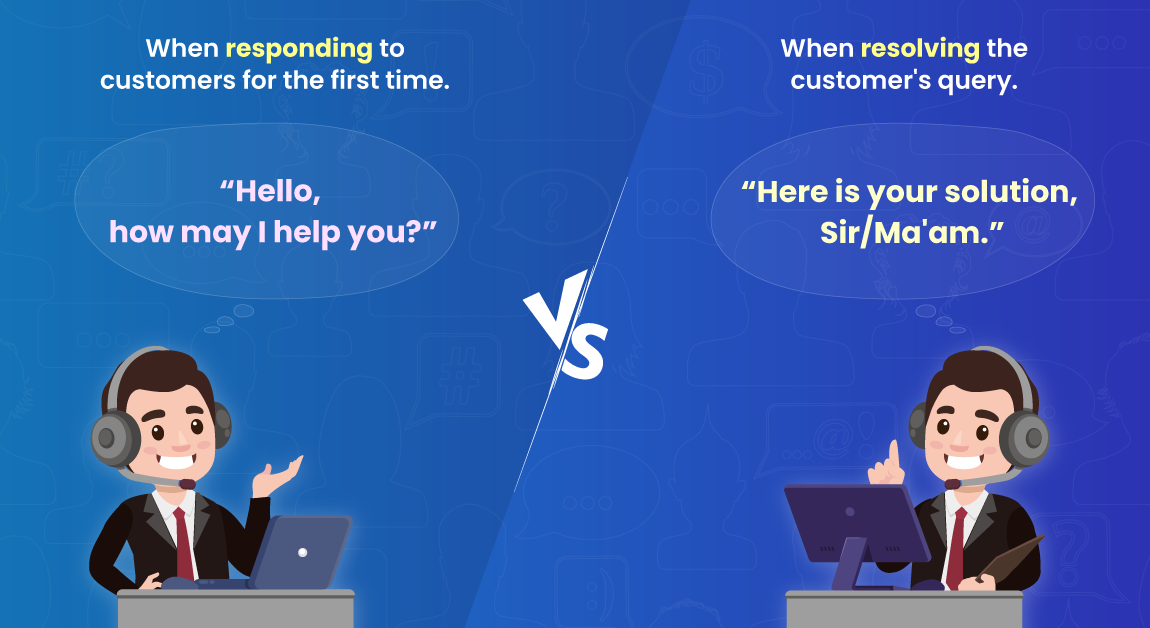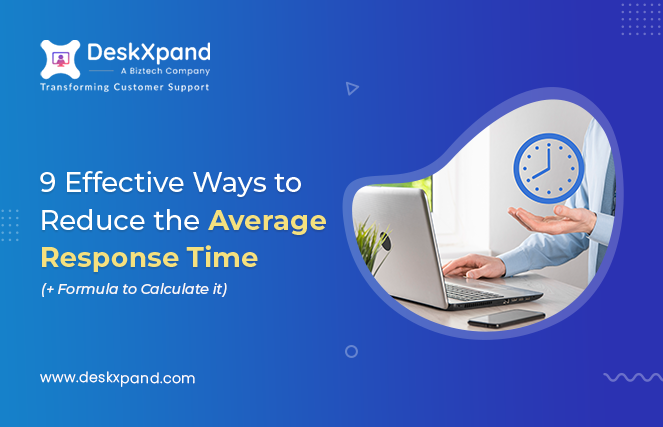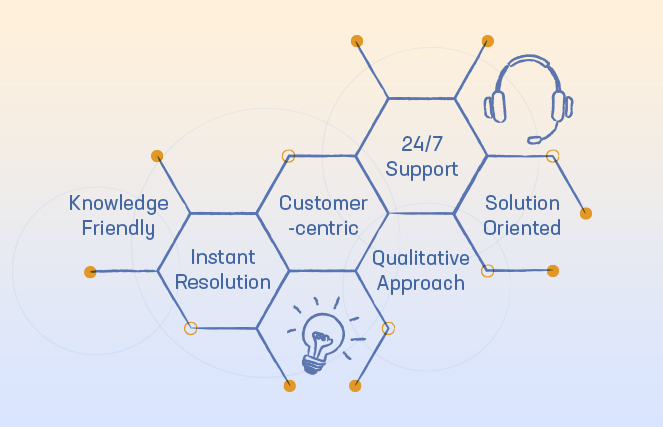Introduction
In today’s hyper-connected world, providing swift and top-notch support is essential to delight your customers.
This comprehensive guide unveils proven strategies to streamline your support processes, resulting in faster customer service resolution times and heightened customer satisfaction.
Moreover, we’ll equip you with a formula to measure and analyze your support time, empowering you to optimize performance continuously.
Whether you’re a budding startup or an established enterprise, these actionable tips will supercharge your support team, leading to exceptional customer experiences.
Let’s embark on this journey to transform your customer support landscape!
What is the Average Resolution Time?
Resolution time is the average time the customer service agent takes from the moment the ticket is initiated until the time solution is found. In simple words, it is time to resolve a customer issue. Resolution time is also known as the time to resolution (TTR) and mean time to resolution (MTTR).
Formula to Calculate the Average Resolution Time
Calculating the average resolution time will help you better understand your service processes. It will give you an insight into how much average time customer service agents take to resolve queries. If the number is low, your support is doing fine, but if it is high, you must consider of changing your strategies in order to lower the average resolution time.

Let’s calculate the average resolution time:
Suppose there are 100 tickets solved over a period of one month, and the total time taken to resolve those queries is 80000 Minutes.
You just need to divide 80000 by 100.
You will get 800 Minutes, which is 13.33 Hours.
So, 13.33 hours is your average resolution time.
This way, you can find out the average resolution time with access to just a little data.
Response Time Vs. Resolution Time
When you are tracking the performance of your support department, it is crucial to know the difference between response time and resolution time.

Response time refers to the time it takes for the service agents to initiate the query and respond to it. This metric helps to manage the customer expectations from your service department. Responding fast enhances customer trust and loyalty in your business. It makes them feel your business cares for them and gives their best to find out a solution. However, a fast response does not mean the issue will also be resolved quickly.
Resolution time refers to the time taken by agents from the moment the ticket is initiated to the time the ticket is resolved. It is a more crucial metric when compared to response time, as it reflects the overall customer service resolution processes. The lower the response time, the better the customer experience. Lower response time is good, but agents should also focus on accuracy to get the best possible results.
Hence, these are both vital metrics that can help the support department to understand their performance more thoroughly and helps them to make the necessary changes in their support process.
Why Ticket Average Resolution Time Matters in Customer Service
Average resolution time is a critical factor in customer service that can significantly impact the overall customer experience and business success. A swift ticket resolution time is crucial because it directly correlates with customer satisfaction and loyalty. When customers encounter problems or have inquiries, they expect prompt solutions that demonstrate the company’s commitment to their needs.
Prolonged customer service resolution times can lead to frustration, dissatisfaction, and even loss of valuable customers. On the other hand, efficient and timely customer query resolution creates a positive impression, building a sense of trust and confidence in the brand.
Beyond customer satisfaction, ticket resolution time also affects operational efficiency. The longer it takes for a support team to address issues, the more resources are consumed, impacting costs and productivity. Focusing on reducing average resolution time promotes a more streamlined workflow, freeing up staff to attend to other tasks and enabling the company to handle a higher volume of inquiries effectively.
Furthermore, ticket average resolution time directly ties into reputation management. With social media and online reviews playing a significant role in shaping public opinion, a company’s ability to swiftly resolve customer issues can significantly impact its online reputation. A reputation for excellent customer service can attract new customers and positively influence the decision-making process for potential buyers.
Therefore, average resolution time matters in customer service because it is the chain that holds together customer satisfaction, operational efficiency, and reputation management. Companies that prioritize reducing ticket resolution time are better positioned to create loyal customers, optimize their resources, and build a strong and positive brand image.
What is an Acceptable Average Resolution Time?
An acceptable average resolution time in customer service is the timeframe within which a customer’s issue or inquiry is addressed to their satisfaction. While the ideal customer service resolution time may vary depending on the nature of the business and the complexity of the problems, there are general benchmarks that can guide companies in setting reasonable targets. In most cases, customers expect a timely response that demonstrates a genuine effort to help. For simpler issues, such as basic inquiries or minor technical glitches, an acceptable average resolution time could range from a few minutes to a few hours.
However, for more complex problems or those requiring in-depth investigation, customers may find an acceptable average resolution time to be within one business day or up to 24 hours. In some industries, an even shorter average resolution time may be necessary. It’s essential for businesses to consider the impact of the issue on the customer’s experience and prioritize urgent cases accordingly.
Ultimately, an acceptable average resolution time is one that aligns with customer expectations, ensures a high level of satisfaction, and reinforces the company’s commitment to providing exceptional customer service. Striking this balance helps build loyalty, trust, and positive word-of-mouth, contributing to the overall success and growth of the business.
8 Ticket Resolution Time Challenges
i. Going Back-and-forth for Collaboration
Collaboration is crucial when it comes to customer service, but it makes no sense if it’s the reason for the high ticket resolution time. If the collaboration process is not streamlined, customer support agents have to go back and forth to collaborate. Hence, agents avoid collaboration which results in spending a lot of their own time wasting solving the customer query.
ii. Lack of Information from the Customers
When in the process of solving queries, service agents require as much information as possible to find the most appropriate solution for the customer. But sometimes, what happens is, while raising a query, customers do not provide all the required information. Instead of using the time to find a solution, agents have to use that time to gather the needed information. And they may take a lot of time to resolve queries.
iii. The Initial Response Time is also High
Customer service is already a challenging task, and to add salt to the injury, the complex process makes it even worse. It keeps that many customers’ queries remain pending, resulting in high response time. And high response time, more often than not, results in high customer service resolution time. For example, instead of initiating a query on the same it is raised, it is initiated after two days. And it only took one more day to find the solution. The time taken to resolve the query is one day, but it’s three long days for the customers. Hence, the initiation or the first response to the ticket is equally important, and service teams should also focus on keeping it low, as it directly impacts the average resolution time.
iv. Customers Not Responding to Follow-Ups Quickly
Once a customer has raised a query, they think now it’s the responsibility of the service agents to find a solution. And they are not wrong. But in order to find a solution, agents might need the help of customers, they might require some details that might be necessary for the customer complaint resolution. So, when customers do not reply to the service agents’ follow-ups, it will only increase the average resolution time.
v. Solving Complex Queries Without Expertise
Customer service agents are well-trained to handle any type of query. But as with any other job, on some occasions, they also require the expertise of their seniors to solve complex queries. But, sometimes, due to the unavailability of expert individuals/seniors or lack of collaboration, agents might try to solve the complex queries on their own. They may consume a lot of time and still be unable to find a proper solution.
vi. Language Barriers Between Customer & Agent
In customer service understanding the customers is the main focus of the service agents. It is the first step in the whole process of solving a customer’s query. How will an agent solve a query they do not understand due to a language barrier? It would become a next to impossible task, as they do not know where to start, what to do, and how to find a solution. This situation might not occur as often as others, but whenever such an issue is faced, it surely increases the average resolution time.
vii. Agents not Having the Right Resource
The customer service department has a lot on their plate. And not having a proper resource only make things worse for them. Without it, they have to work on every single query manually, respond to repetitive queries over and over again, they cannot streamline their support process, cannot take data-driven decisions, etc. It impacts their efficiency and productivity in a negative way. This results in them consuming a lot of time to resolve queries.
viii. Not Prioritizing Tickets Effectively
Every day a lot of customers raise queries and expect that the agents will provide them with a solution within a few hours. All the queries are not similar, some might be easy to solve, and some might be complex. But still, resolving them as quickly as possible is the job of a service agent. But sometimes, what happens is, agents do not prioritize these queries properly and end up spending more of their time on more straightforward queries. And while solving complex queries when they require more time, they do not have it, making the customer service resolution process slow and frustrating.
9 Effective Ways to Lower the Resolution Time
1. Create a Knowledge Base or FAQ Page
A lot of customers want to deal with their queries by themselves. They don’t want to be in a long queue and wait for a response from a service agent. Businesses must look at this as an opportunity to lower their average resolution time. By providing a knowledge base or FAQ page, they can help customers to become independent. As customers can solve their own queries, the number of queries generated is comparatively less. This way, agents can focus more on solving those queries and provide timely solutions, keeping the average resolution time well under control.
2. Automate Support Processes as Much as Possible
Who does not like having a little extra help while working? Everyone does. And in customer service, there is nothing more helpful than getting rid of manual tasks or repetitive tasks that consume a lot of service agents’ time. Automating everyday tasks such as ticket assigning, auto priority setting, automatic trigger notification, etc., helps agents to save time and focus on more crucial tasks. In short, automation allows agents to do more work in less time, resulting in a positive impact on customer service resolution time.
3. Assign Tickets to the Most Appropriate Agents
Not every ticket is the same and not every agent has the expertise to solve each and every ticket. Some agents might be new to the process and might not know how to find a quick solution. But for some agents who have been in the customer support sector for a long period of time, finding a solution for some queries might be a piece of cake. So, while assigning tickets, always ensure that the high-priority or emergency tickets that need immediate attention are assigned to experienced agents. At the same time, low-priority or less complex tickets are assigned to the new or less experienced agents. This way, the customer problem resolution process might get a little less hectic, and the results will be better.
4. Start Using the Right Software
Customer queries and raised tickets are often cluttered making it hard to understand how to route them to the right agent for the quickest resolution. Therefore, having the right software has become necessary to organize and manage customer tickets. And customer support software can be the perfect solution for that. It has features that ensure the support agents’ work productivity. Features include analytics, automation, omnichannel support, live chat, canned responses, task management, etc. These features allow the agents to cover each and every customer query and solve them on time without any hassle.
5. Prioritize Tickets Effectively
Every query has different complexity; customer service teams need to understand that and prioritize them accordingly. Effectively prioritizing tickets will give them a better chance to solve them on time, and with accuracy. Complex queries can be managed first, and easier ones can be taken up later, thus making service teams more efficient.
6. Train your Support Agents
Customer service agents are the face of your business, as they are the ones with whom your customers interact whenever they have any issues. That is why it is important to train them, so they can effectively help customers. It is important that they have the proper understanding of your each product, company policies, etc. so that they can solve customer queries effectively. A smooth service process also enhances customer satisfaction and builds stronger relationships.
7. Track and Monitor the Support Team’s Performance
Every business needs to know how its customer service department works because the more effective the support department is, the more delighted the customers are. That is why, tracking and monitoring the performance of the support department and of every individual service agent is crucial. It gives insights into how much time is taken by particular agents to solve queries, how many queries are totally solved, how many queries are solved by a particular agent, how long it takes agents to respond to the customer queries, etc., all these metrics showcase how efficiently support team/agents are working. It also shows If there is any flaw in the process, and if there is, then you can ensure it is solved. This way, you can reduce the customer query resolution time.
8. Invest in a Shared Inbox for Greater Visibility
Investing in a shared inbox can significantly enhance the efficiency of service teams and reduce customer complaint resolution times. By consolidating all customer inquiries, feedback, and issues into a single, easily accessible platform, team members gain greater visibility into ongoing conversations. This eliminates the risk of messages getting lost or overlooked, allowing agents to address and prioritize customer needs promptly. Collaboration is streamlined as team members can seamlessly communicate, share insights, and delegate tasks within the shared inbox.
9. Prioritize Omnichannel Communication
Nowadays, in the era of social media, when almost everyone has a presence on social media, it becomes crucial that you offer your customers omnichannel support. It ensures that every single query raised on multiple social media platforms such as Whatsapp, Facebook, Instagram, etc., is converted into actionable tickets. This way, it becomes easy for service agents to offer high-quality service and lower the customer problem resolution time, as they do not have to go back and forth anymore to solve queries. Ultimately, offering omnichannel support helps service agents to improve efficiency and enhance customer experience.
Key Takeaways
In conclusion, reducing customer support time is not only a goal but a necessity for businesses aiming to deliver exceptional customer experiences. The 9 effective strategies outlined above can help service teams to achieve this objective. By employing techniques such as optimizing self-service options, investing in AI-powered chatbots, and training support agents to excel in efficiency and empathy, companies can streamline their support processes and significantly lower customer query resolution times.









